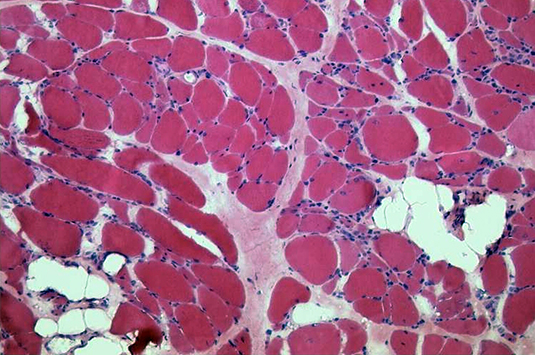Researchers identify cause of hereditary skeletal muscle disorder

Muscle biopsy of a patient: lost muscle tissue (red) has been replaced by connective tissue (pink) and adipose tissue (white)
The starting point for this discovery was a family in which two of six children dad been living with delayed motor development and muscle weakness since birth. In addition to skeletal muscles, eyes and brain seemed to be affected as well: Both patients developed early-onset cataracts and had mild mental retardation.
The scientists analysed the whole exome of the patients, that is to say all regions of the DNA that encode proteins. This analysis resulted in a suspicious variant in the gene INPP5K, which appeared to be related to the manifestation of the disease. Definite proof came from genetic studies involving further unrelated patients with the same disorder: Together with colleagues at home and abroad, the research team came across INPP5K mutations in seven additional families.
In order to understand the mechanism of the disorder, the researchers investigated the function of INPP5K in zebrafish larvae. The loss of INPP5K caused defective development of skeletal muscles and eyes, replicating essential features of the human disease.
The INPP5K gene provides the blueprint for making an enzyme that controls the turnover of phosphoinositides, small lipids that are involved in the regulation of a variety of cell and organ functions. Further experiments indeed showed that most disease-related INPP5K mutations resulted in strongly impaired enzyme function.
The association between abnormal phosphoinositide metabolism and hereditary human diseases had already been demonstrated in earlier studies. However, mutations did not affect the INPP5K gene but were found in genes for other phosphoinositide-metabolizing enzymes.
The condition caused by INPP5K mutations is one of the rare diseases. “It was only thanks to a worldwide cooperation with doctors and geneticists, that we were able to identify several affected families and confirm our initial suspicion,” says Professor Jan Senderek from the Friedrich Baur Institute of the University Hospital of Munich (LMU) and last author of the publication.
Although the results of the study do not yet establish a causative therapy, the identification of the gene defect is expected to pave the way for the search for new treatment options. And already now, the results are of practical importance, as Professor Senderek notes: “The discovery of the cause of the disease enables targeted genetic diagnostics and counselling of affected families and thus contributes to improved care of patients with this rare disease.”
Journal reference:
Wiessner et al.: Mutations in INPP5K, Encoding a Phosphoinositide 5-Phosphatase, Cause Congenital Muscular Dystrophy with Cataracts and Mild Cognitive Impairment. American Journal of Human Genetics, 2017,
DOI: http://dx.doi.org/10.1016/j.ajhg.2017.01.024
Contact:
Prof. Dr. Jan Senderek
Friedrich-Baur-Institut an der Neurologischen Klinik und Poliklinik
Klinikum der Universität München (LMU)
Campus Innenstadt
Tel.: +49 89/4400-57415
e-mail: jan.senderek@med.uni-muenchen.de
Media Contact
All latest news from the category: Health and Medicine
This subject area encompasses research and studies in the field of human medicine.
Among the wide-ranging list of topics covered here are anesthesiology, anatomy, surgery, human genetics, hygiene and environmental medicine, internal medicine, neurology, pharmacology, physiology, urology and dental medicine.
Newest articles

Bringing bio-inspired robots to life
Nebraska researcher Eric Markvicka gets NSF CAREER Award to pursue manufacture of novel materials for soft robotics and stretchable electronics. Engineers are increasingly eager to develop robots that mimic the…

Bella moths use poison to attract mates
Scientists are closer to finding out how. Pyrrolizidine alkaloids are as bitter and toxic as they are hard to pronounce. They’re produced by several different types of plants and are…

AI tool creates ‘synthetic’ images of cells
…for enhanced microscopy analysis. Observing individual cells through microscopes can reveal a range of important cell biological phenomena that frequently play a role in human diseases, but the process of…





















